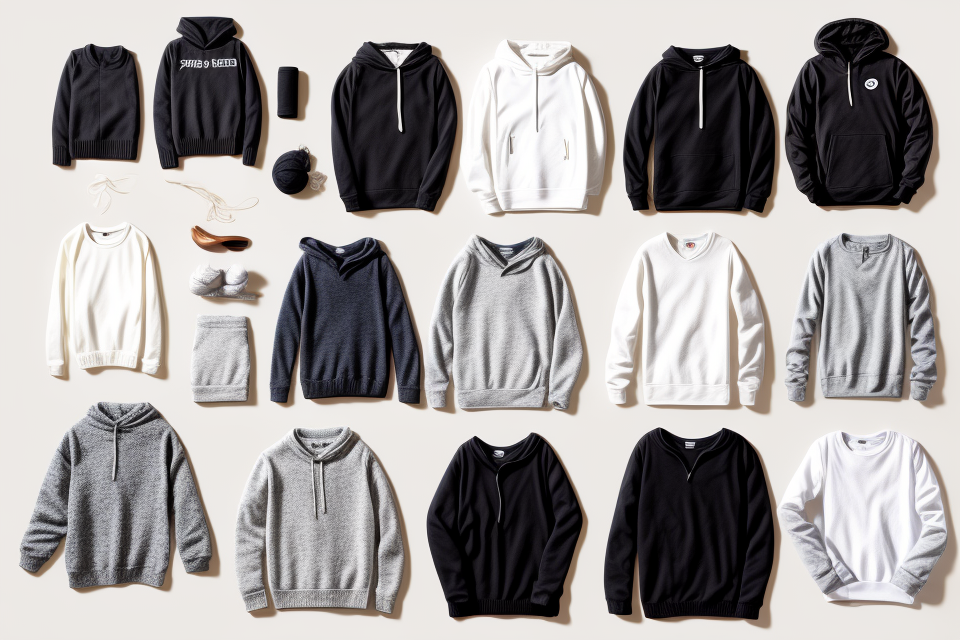Are you confused about the difference between a sweater and a hoodie? You’re not alone! Many people use these two terms interchangeably, but they actually refer to different types of clothing. In this comprehensive guide, we’ll explore the differences between sweaters and hoodies, including their history, design, and functionality. So whether you’re a fashion enthusiast or just looking to update your wardrobe, read on to discover the key distinctions between these two popular garments.
The Basics: What is a Sweater?
Definition and Characteristics
A sweater is a type of garment that is typically worn on the upper body, usually made of wool, cotton, or other fibers. It is a versatile piece of clothing that can be worn in a variety of settings, from casual outings to formal events. Sweaters are often worn as a layer of clothing underneath a jacket or coat, or as a standalone piece.
Sweaters are typically designed with long sleeves and a round neckline, although they can also be found in other styles. They are known for their warmth and comfort, making them a popular choice for cold weather wear. In addition to their practical benefits, sweaters are also a fashion statement and can be worn to make a statement or add a pop of color to an outfit.
History and Cultural Significance
Sweaters have been a staple in clothing for centuries, with evidence of their use dating back to ancient civilizations. They were originally worn as a form of protection against the cold, but over time they have become a popular fashion item and are often associated with specific styles or trends.
In modern times, sweaters have taken on different meanings and have been used as a symbol of cultural identity or affiliation. For example, the Fair Isle sweater, which originated in the Shetland Islands of Scotland, has become a symbol of Scottish heritage and is often worn as a way to celebrate and maintain cultural traditions. Similarly, the Aran sweater, which originated in Ireland, has become a symbol of Irish heritage and is often worn as a way to celebrate and maintain cultural traditions.
Additionally, the history of sweaters has been shaped by the development of new technologies and materials. For example, the invention of the knitting machine in the 16th century made it possible to produce sweaters on a larger scale, leading to their widespread use. And the introduction of synthetic fibers in the 20th century has allowed for the production of sweaters that are both warm and lightweight, making them a popular choice for a wide range of activities and occasions.
Overall, the history and cultural significance of sweaters is rich and varied, and they continue to play an important role in fashion and culture today.
The Basics: What is a Hoodie?
A hoodie is a type of sweatshirt that is designed with a hood in the back, which can be worn up to cover the head and neck. This hood is often adjustable and can be worn in different positions, depending on the wearer’s preference.
Hoodies are typically made of a lightweight, breathable fabric such as cotton or polyester. They are often designed with a loose fit and long sleeves, which can be cuffed or uncuffed. The cuffs may also have a thumb hole to keep the sleeves in place while the hands are in the pockets.
Hoodies are often worn as a casual, everyday garment and are popular among both men and women. They are a versatile piece of clothing that can be dressed up or down, making them a popular choice for both formal and informal occasions. Hoodies are also a popular choice for athletes and people who enjoy outdoor activities, as they are comfortable and provide warmth without being too heavy.
While hoodies are now a staple of modern fashion, their origins can be traced back to the early 20th century. Originally designed as a type of workwear for athletes and laborers, hoodies have since become a popular fashion item and have been adopted by various subcultures. However, their association with certain social and political movements has also led to controversy and criticism.
In the early 20th century, hoodies were first introduced as a type of functional clothing for athletes and laborers. They were designed to provide warmth and protection from the elements, and were often made of heavy materials such as denim or corduroy. The hood, which is a distinctive feature of the hoodie, was added to provide additional protection from the elements by covering the head and neck.
Over time, hoodies became more fashionable and began to be worn by people outside of the athletic and labor communities. In the 1980s, hoodies gained popularity as a casual, everyday garment, and were often worn as part of the hip-hop and skateboarding subcultures. In the 1990s, hoodies became even more widespread, thanks in part to the rise of grunge and punk fashion.
Despite their widespread popularity, hoodies have also been the subject of controversy and criticism. In recent years, hoodies have been banned in some schools and other public places due to their association with certain social and political movements. Some people have also criticized hoodies as being a symbol of criminality and disrespect, which has led to debates about the appropriateness of wearing hoodies in certain contexts.
In conclusion, while hoodies have a long history as a type of functional clothing for athletes and laborers, they have also become a popular fashion item that has been adopted by various subcultures. However, their association with certain social and political movements has led to controversy and criticism, and has sparked debates about the appropriateness of wearing hoodies in different contexts.
Comparing Sweaters and Hoodies
Physical Differences
When it comes to the physical differences between sweaters and hoodies, there are several key distinctions to consider.
Fabric
One of the most obvious differences between sweaters and hoodies is the fabric they are made of. Sweaters are typically made of thicker, warmer fabric than hoodies, which are often made of a lighter, more breathable material. This means that sweaters are better suited for colder weather, while hoodies are more appropriate for milder temperatures or as a layering option.
Sleeve Style
Another physical difference between sweaters and hoodies is the style of their sleeves. Sweaters are usually designed with long sleeves and a round neckline, while hoodies often have a hood in the back and may have a drawstring to adjust the fit. This means that hoodies are often more versatile than sweaters, as they can be worn with or without the hood, and can be adjusted to fit a variety of body types.
Hood
The presence of a hood is another key physical difference between sweaters and hoodies. As mentioned, hoodies often have a hood in the back, which can be useful for keeping the head and neck warm in cold weather. Sweaters, on the other hand, do not typically have a hood.
Overall, the physical differences between sweaters and hoodies are significant, and it is important to consider these factors when deciding which type of garment to wear. Sweaters are typically warmer and better suited for colder weather, while hoodies are more versatile and can be worn in a variety of settings.
Style and Fashion
While sweaters and hoodies may seem similar at first glance, they actually have distinct style and fashion characteristics that set them apart.
- Sweaters are often associated with more formal or traditional styles, with many classic designs featuring intricate patterns or cable knit textures. They can be worn as a layer under a suit jacket or blazer for a polished, professional look, or paired with jeans and boots for a more casual yet stylish outfit. Sweaters can also be dressed up or down for various occasions, making them a versatile wardrobe staple.
- Hoodies, on the other hand, are often seen as casual or sporty, with many designs featuring bold graphics or logos. They are commonly worn as part of an athlete’s uniform or as a casual, everyday garment. While hoodies can be dressed up for certain occasions, they are typically more associated with a relaxed, laid-back style.
However, it’s important to note that these associations are not absolute, and both sweaters and hoodies can be worn in a variety of styles and contexts. For example, a hoodie can be paired with dress pants and a tie for a more formal look, while a sweater can be worn with ripped jeans and sneakers for a casual, streetwear-inspired outfit. Ultimately, the key to pulling off any style is to wear what makes you feel confident and comfortable.
Uses and Functionality
When it comes to the uses and functionality of sweaters and hoodies, there are some key differences to consider.
Sweaters
Sweaters are typically worn as a layer of clothing underneath a jacket or coat. They are designed to keep the wearer warm and cozy, and are often made from materials such as wool or acrylic. Sweaters can be worn for a variety of occasions, from casual outings to formal events, and can be dressed up or down depending on the occasion.
In addition to their practical uses, sweaters are also sometimes used as a symbol of cultural identity or affiliation. For example, the Fair Isle sweater, which originated in the Shetland Islands of Scotland, is a traditional style of sweater that is often associated with Scottish heritage.
Hoodies
Hoodies, on the other hand, are typically worn as a standalone garment. They are designed to be worn over a T-shirt or long-sleeved shirt, and feature a hood that can be pulled up to cover the head and neck. Hoodies are often made from materials such as cotton or fleece, and are designed to be comfortable and casual.
Hoodies are often associated with specific subcultures or social movements. For example, the hoodie has become a symbol of resistance and solidarity in the wake of police violence against people of color. The “I Can’t Breathe” hoodie, named after the last words of Eric Garner, who was killed by police in 2014, has become a symbol of the Black Lives Matter movement.
In summary, while both sweaters and hoodies are designed to keep the wearer warm and cozy, they have different uses and associations. Sweaters are often worn as a layer of clothing underneath a jacket or coat, while hoodies are typically worn as a standalone garment. Sweaters are sometimes used as a symbol of cultural identity or affiliation, while hoodies are often associated with specific subcultures or social movements.
FAQs
1. What is a sweater?
A sweater is a type of garment that is typically worn on the upper body. It is typically made of wool, cotton, or other types of yarn, and is designed to keep the wearer warm. Sweaters are often worn as a casual, everyday garment, and are often worn in the fall and winter months.
2. What is a hoodie?
A hoodie is a type of sweatshirt that has a hood in the back that can be worn over the head. It is typically made of a thick, warm fabric, such as cotton or fleece, and is designed to be worn as a casual, everyday garment. Hoodies are often worn as a layer underneath a jacket or coat, or as a standalone garment.
3. What are the differences between a sweater and a hoodie?
The main difference between a sweater and a hoodie is the design and construction of the garment. A sweater is typically a more formal, traditional type of garment, while a hoodie is a more casual, everyday garment. Sweaters are often made of finer yarns and are more fitted in their design, while hoodies are typically made of thicker, warmer fabrics and have a more relaxed fit. Additionally, sweaters do not have a hood, while hoodies do.
4. Can a sweater be used as a substitute for a hoodie?
In some cases, a sweater can be used as a substitute for a hoodie. However, there are some key differences between the two garments that may make one more suitable for a particular situation than the other. For example, a sweater may be warmer than a hoodie, but it may also be less comfortable to wear for long periods of time. Additionally, a sweater may not have the same level of versatility as a hoodie, as it may not have the same range of motion in the sleeves and hood.
5. What are some common materials used to make sweaters and hoodies?
Both sweaters and hoodies can be made from a variety of materials, including wool, cotton, fleece, and synthetic fibers. Wool is a common material used to make sweaters, as it is warm and durable. Cotton is also a popular choice for sweaters, as it is lightweight and breathable. Fleece is a common material used to make hoodies, as it is warm and comfortable to wear. Synthetic fibers, such as polyester and nylon, are also commonly used to make both sweaters and hoodies, as they are durable and easy to care for.
6. How should I care for my sweater or hoodie?
The care instructions for a sweater or hoodie will depend on the type of material it is made from. In general, sweaters and hoodies made from natural fibers, such as wool and cotton, should be washed in cold water and dried on a low heat setting. Hoodies made from synthetic fibers, such as polyester and nylon, can typically be washed in cold or warm water, and can be dried on a high heat setting. It is important to check the care label on your garment for specific instructions.



